Archive:Production and turnover trends in Croatia and in the European Union
Short-term business statistics for Croatia and the European Union
Statistics in Focus 23/2013; Author: Thomas JAEGERS
ISSN:2314-9647 Catalogue number:KS-SF-13-023-EN-N
This Statistics Explained article is outdated and has been archived - for recent articles on production and turnover see here.
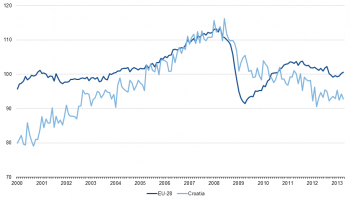
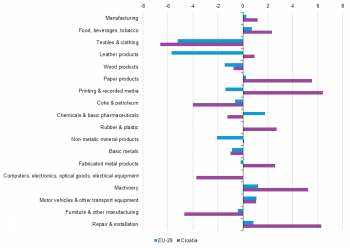
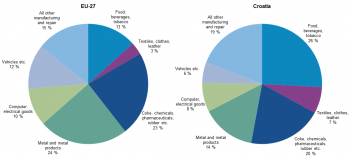
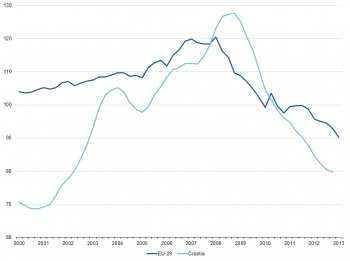

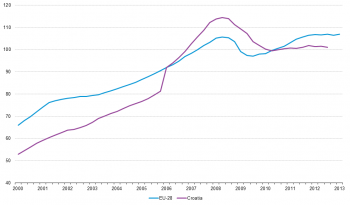
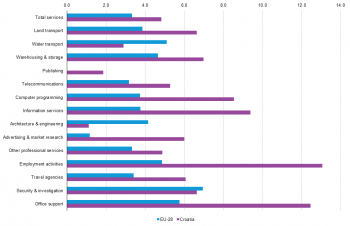

On 1 July 2013 Croatia became the 28th Member State of the European Union. This article presents results from short-term business statistics (STS) (and some selected data from structural business statistics) for Croatia and compares them with results for the EU-28. The article focusses on trends in production indicators for industry and construction and on the volume trends in retail trade. Since production data for services are not yet available in STS turnover trends are presented.
Main statistical findings
Industry
Between the years 2000 and 2007, i.e. before the financial and economic crisis, the average annual growth of the industrial production index in the EU-28 had been approximately 1.7 % (Figure 1); in April 2008, the index for the EU-28 reached its maximum level (113.6). In Croatia the average rate of change between 2000 and 2007 was 4.5 %. The highest level of the industrial production index was only reached in June 2008 (116.2).
Between April 2008 and April 2009 industrial production in the EU-28 dropped by more than 22 percentage points. Afterwards however a relatively dynamic recovery set in for about 2 years. Since May 2011 industrial production has again fallen. The EU’s average industrial production index for the first months of 2013 is comparable to the level in 2003.
In Croatia the fall in industrial production during the crisis was slower than in the EU as a whole. In the months between June 2008 and January 2009 the index dropped by 15 percentage points and then even recovered somewhat in the spring of 2009. Since then there has however been a relatively steady decline, and between 2009 and 2012 the industrial production index fell at an average annual rate of more than 2.6 %. As for the EU-28, Croatia’s average industrial production index for the first months of 2013 is comparable to the level in 2003.
Between 2000 and 2012 the various sectors in manufacturing (i.e. the largest part of industry) developed quite differently in the EU-28 and in Croatia (Figure 2). Overall manufacturing grew more strongly in Croatia than in the other Member States (annual average growth 1.2 % compared with 0.3 % for the EU-28). In several sectors – food, beverages and tobacco; paper products, machinery, transport equipment, repair and installation – both the EU-28 and Croatia displayed positive growth. However, there are often noticeable differences in the size of the growth rates, especially for paper products, machinery and repair and installation where growth rates in Croatia were several times higher than in the EU-28 (Figure 2). In other areas – textiles and clothing, wood products, coke and petroleum products, basic metals, and furniture and other manufacturing – both the EU-28 and Croatia show falls over the period 2000 – 2012. Where the direction of the change differed there was generally growth in Croatia compared with a decline in production in the EU-28, i.e. in leather products, printing and recorded media, mineral products, and fabricated metal products. In computers, electronics, optical goods and electrical equipment there was stagnation in the EU-28 and a decline in Croatia.
The different development trends have to be seen against the background of a different structure of the Croatian manufacturing sector compared with the European average (Figure 3). In particular, it can be noted that the relative shares of food, beverages and tobacco and of textiles, clothes and leather products in the Croatian economy are twice as high as in the EU-27. In contrast, the shares of the industries producing metal and metal products as well as the industries manufacturing vehicles, transport equipment and metal and metal products are roughly only half as large in Croatia as in the EU-27 (Figure 3).
Construction
Figure 4 provides an overview of the construction sectors in Croatia and in the EU-28. In many respects the development in construction is similar to the development in industry (see above). Between 2000 and 2007 the average annual growth of production in construction was 2.3 % in the EU-28; while for Croatia, the rate was 8.7 %.
As in the case of industrial production the peak of the economic development occurred somewhat later in Croatia than in the EU-28 (in the last quarter of 2008 instead of in the first). Since then however production in the construction sector has been on a steady decline in both Croatia and the EU-28. Between the pre-crisis peak and the first quarter of 2013 European production in construction dropped by 30 percentage points, in Croatia the fall between the most recent data (last quarter 2012) and the pre-crisis high was nearly 48 percentage points. This corresponds to annual rates of change between 2008 and 2012 of -4.8 % in the EU-28 and -10.3 % in Croatia.
Retail trade
Neither in the EU-28 nor in Croatia did the volume of retail trade show such a pronounced decline during the financial and economic crisis as was the case for industrial production and production in construction (Figure 5).
As in other economic areas the years between 2000 and 2008 were characterised by a catching up of the Croatian economy. In Europe a comparatively moderate decline in the volume of retail sales started in February 2008. Since 2009 the level of retail trade has remained almost unchanged. In Croatia the decline of deflated turnover in retail trade was much larger (from an index level of 111.8 in April 2008 to a level of 99.2 two years later). Between 2010 and 2012 the volume of retail trade remained relatively stable and only in the past year has started to decline again.
In both the EU-28 and Croatia the levels of retail trade in food and non-food have converged over recent years. Moreover, retail trade in non-food products has been slightly more volatile than retail trade in food products.
Services
Between 2000 and 2007 the turnover in market business services (excluding insurance and banking) grew at an average annual rate of 5.5 % in the EU-28 and of 9.9 % in Croatia (Figure 6). For both the EU-28 and Croatia index levels peaked in the second quarter of 2008. Within just over one year the service turnover index in the EU-28 lost almost 9 percentage points. Between mid-2009 and 2012 however there has been an average annual growth of around 2.9 % and the European service turnover index already regained its pre-crisis high in 2011. In Croatia the decline of turnover in services lasted significantly longer (more than two years) and was stronger (almost 15 percentage points). Moreover since mid-2010 market business turnover has remained largely unchanged.
Figure 7 provides a breakdown of the overall development in the services sector. Between 2000 and 2012 the average annual rates of change have been positive for all service industries covered by short-term statistics (with the exception of publishing in the EU-28). However, there have been marked differences in the size. On average, growth rates have been around 2 ½ percentage points higher in Croatia than in the EU-28. The only exceptions to this general trend were water transport and architectural and engineering services.
Similarly to the average growth rates for manufacturing, these results have to be seen in relation to the different structures of the service sectors in the EU-27 and in Croatia (Figure 8). The relative size of the transportation and storage sectors (excluding air transport for which Croatian data are not available) is roughly comparable in the EU-27 (23 %) and Croatia (24 %). However in Croatia accommodation and food services play a much more important role (15 %) than in the EU-27 (9 %). On the other hand, the relative importance of administration support services is more than twice as high in the EU-27 (18 %) than in Croatia (8 %).
Data sources and availability
Information about economic short-term developments is collected by the national statistical institutes with business surveys; in addition administrative data are used. Comparability between the national results published by Eurostat is ensured by detailed legal rules regarding the definitions of indicators, the level of detail, reference periods, etc. These rules are laid down in Council Regulation 1165/98 of 19 May 1998[1] concerning short-term statistics and its subsequent amendments.
The industrial production index and the construction production index measure changes in deflated output. The indicator reflects volume developments in value added. Where data needed to compile such an index are not available on a short-term basis, suitable proxies (e.g. sales or hours worked) are used.
The volume measure of the retail trade turnover is a short-term indicator for final domestic demand. It is a deflated version of the turnover index for retail trade.
The aim of the service turnover index is to show the development of the market for services. Turnover, or sales, comprises the total invoiced by an observation unit (enterprise) during the reference period and this corresponds to market sales of goods to third parties.
Context
Short-term statistics (STS) describe the most recent developments of European economies. STS cover four major economic domains: industry, construction, retail trade and other services (for example transport, information and communication, business services but not financial services).
In the field of STS, the development in the different economic domains is described with a series of indicators (STS indicators) such as production, turnover, producer prices, labour input and several more.
STS indicators are published as indices which show the changes of the indicator in comparison with a fixed reference year (currently 2010).
STS indicators for the EU-28 and the euro area (EA-17) are calculated as weighted averages of countries' indicators. The weights reflect the countries relative sizes in a given base year (currently 2010) for the relevant economic sectors and indicators.
See also
Further Eurostat information
Publications
Database
Dedicated section
Other information
- Regulation 1165/98 of 19 May 1998 concerning short-term statistics
Notes
- ↑ Official Journal No L 162 of 5 June 1998, p. 1-15.